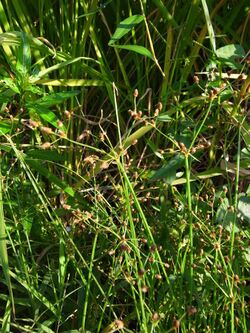Biology:Fimbristylis miliacea
| Grasslike fimbry | |
|---|---|

| |
| Scientific classification | |
| Kingdom: | Plantae |
| Clade: | Tracheophytes |
| Clade: | Angiosperms |
| Clade: | Monocots |
| Clade: | Commelinids |
| Order: | Poales |
| Family: | Cyperaceae |
| Genus: | Fimbristylis |
| Species: | F. miliacea
|
| Binomial name | |
| Fimbristylis miliacea (L.) Vahl
| |
| Synonyms | |
|
Scirpus miliaceus L. | |
Fimbristylis miliacea, the grasslike fimbry[1] or hoorahgrass,[2] is a species of fimbry that probably originated in coastal tropical Asia but has since spread to most continents as an introduced species.[3] It is a widespread weed in some areas and is sometimes problematic in rice paddies.
Description
Fimbristylis miliacea is an annual sedge which grows in clumps of erect stems up to about half a meter in height surrounded by fans of narrow flat leaves.[3] The top of each stem is occupied by an array of spikelets, each borne on a long peduncle.[3] The spikelet is spherical to ovate and reddish brown in color. The spikelets flower and then develop tiny fruits, which are brown achenes about a millimeter long.[3]
Taxonomy
The name Fimbristylis miliacea is a combination made by Martin Vahl based on the name Scirpus miliaceus published by Carl Linnaeus in his 1759 10th edition of Systema Naturae.[4] Because of confusion surrounding this name, and following a failed attempt to conserve the name with a particular sense (nomen conservandum), a successful proposal was made in 2004 to have "Scirpus miliaceus" rejected (nomen rejiciendum) under the International Code of Botanical Nomenclature.[4] The two taxa to which the name Fimbristylis miliacea had previously been applied therefore became Fimbristylis quinquangularis and Fimbristylis littoralis.[4]
Distribution
The species is found throughout many countries with a tropical or sub-tropical climate in southern and south-east Asia including: Australia ,[5] Bangladesh, Bhutan, Cambodia, India , Indonesia, Malaysia, Myanmar, Nepal, Pakistan , Philippines , Sri Lanka, Thailand and Vietnam. It has also been introduced into Ecuador, Madagascar , Nicaragua, Peru and Suriname.[2]
References
- ↑ "Fimbristylis miliacea (L.) Vahl, grass-like fimbry". PLANTS Database. United States Department of Agriculture. http://plants.usda.gov/core/profile?symbol=FIMI. Retrieved November 16, 2013.
- ↑ 2.0 2.1 "Fimbristylis miliacea". International Rice Research Institute. http://www.knowledgebank.irri.org/training/fact-sheets/item/fimbristylis-miliacea. Retrieved 25 October 2017.
- ↑ 3.0 3.1 3.2 3.3 Robert Kral (2003). "Fimbristylis Vahl, Enum. Pl. 2: 285. 1805". Cyperaceae. Flora of North America. 23. Oxford University Press. pp. 121–131. ISBN 978-0-19-515207-4. http://www.efloras.org/florataxon.aspx?flora_id=1&taxon_id=200026798.
- ↑ 4.0 4.1 4.2 Mark T. Strong (2004). "(1644) Proposal to reject the name Scirpus miliaceus (Cyperaceae)". Taxon 53 (4): 1069–1070. doi:10.2307/4135579.
- ↑ "Fimbristylis miliacea". FloraBase. Western Australian Government Department of Parks and Wildlife. https://florabase.dpaw.wa.gov.au/browse/profile/863.
External links
Wikidata ☰ Q4919077 entry
 |


